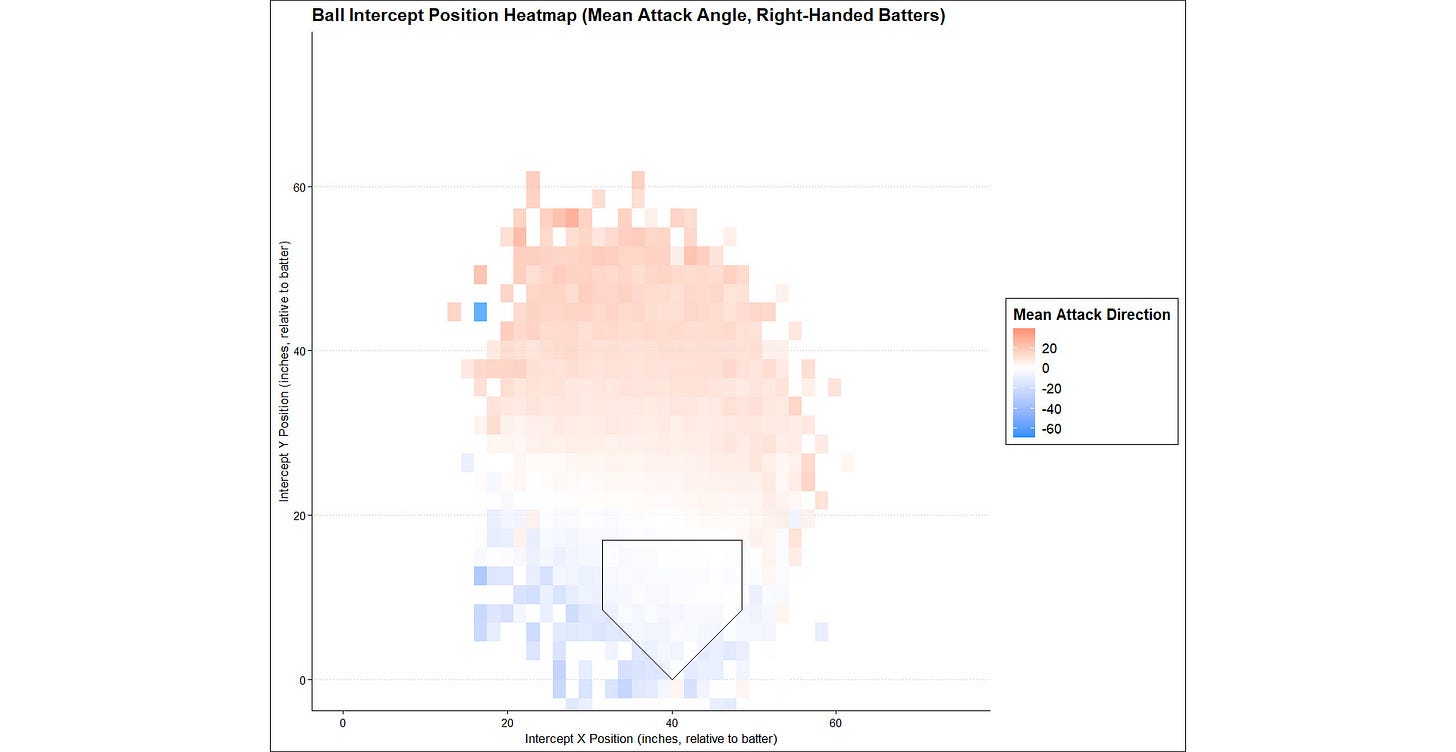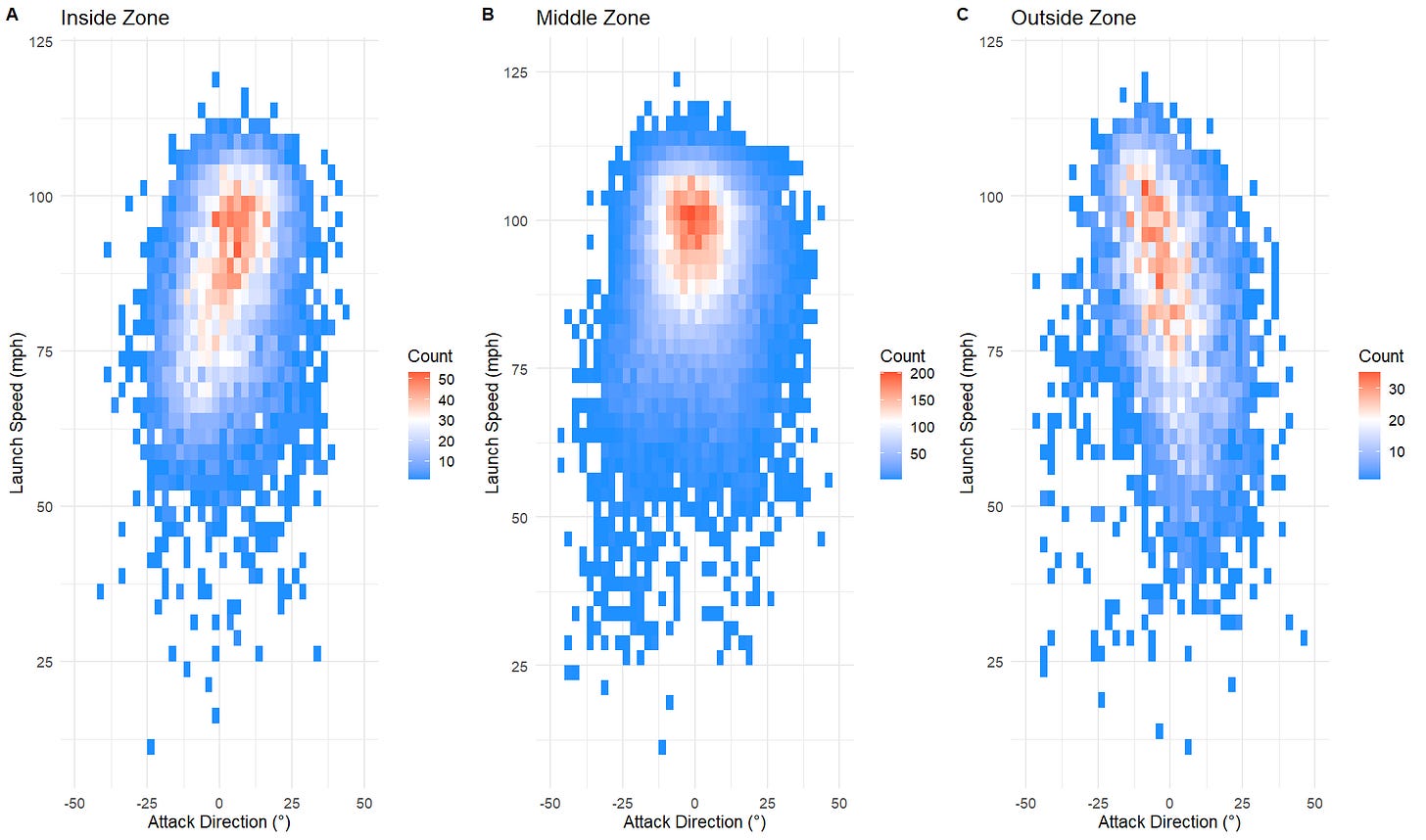The Science of Swing Lanes: Why Attack Direction Matters
Swing direction is one of the most intriguing new metrics to emerge from the latest Baseball Savant data release — a treasure trove of swing-level information from the best hitters on the planet. As we begin to make sense of this dataset, one thing is clear: swing direction isn’t just noise. It has real implications for understanding offensive output, refining player development strategies, and challenging long-held beliefs about hitting.
This is just the beginning. Unpacking this information will take time, and over the next few years, expect it to reshape how coaches, analysts, and front offices evaluate hitters. While much of this has been known behind closed doors in MLB operations, the public baseball world is only starting to catch up.
We have seen prior to this post that Swing Direction is heavily influenced by where a player is contacting the baseball:
As hitters make contact further out in front of their bodies and home plate, the tendency to turn the barrel becomes more pronounced. This is a natural result of the bat and batter rotating around their axis. It makes sense, then, that in the graphic above we see a more opposite-field approach (blue) on pitches deeper in the zone, where contact is made later. Conversely, as hitters are able to extend and finish their swings out front, the bat path naturally shifts toward the pull side (red), reflecting a more aggressive turn of the barrel.
Today, I want to continue exploring swing direction—this time through the concept of “lanes.” Think of lanes as a simplified way to categorize plate locations on balls put into play. By dividing the plate into three basic sections—outside, middle, and inside—we can start to uncover patterns and draw meaningful conclusions about what’s happening beneath the surface.
Why think in terms of lanes?
For me, lanes offer a clean mental model:
Outside pitches tend to produce contact with barrels directed toward the opposite field.
Middle pitches typically result in more neutral attack directions (around 0 degrees).
Inside pitches are more often pulled, with barrels turned aggressively toward the pull side.
It's a framework that isn’t perfect—but it’s practical, and it gives us a consistent way to interpret swing direction in context.
Note: For consistency in the visuals that follow, all left-handed hitters have been flipped to right-handed orientation.
Lets just start with the basic outline here. What we see that this philosophy stands up to the sniff test right away with balls over these different directions slightly different on average from one another.
Let’s take a step back and look at all three lanes—outside, middle, and inside—and examine how hitters perform across them. Specifically, we’re looking at hard-hit rates on balls in play and comparing those to attack direction within each lane.
This gives us a clearer picture of how well hitters are adjusting their swing direction based on pitch location—and whether those adjustments are actually driving quality contact. By isolating attack direction by lane, we can start to see patterns in approach, identify who’s matching path to pitch effectively, and who might be leaving some performance on the table.
What becomes clear in this breakdown is that attack direction plays a significant role in driving hard-hit outcomes—especially on pitches off the edges of the plate. On both inside and outside pitches, there’s a noticeable pattern: barrels that adjust their swing direction appropriately tend to produce higher hard-hit rates.
The middle lane, on the other hand, shows more overlap and inconsistency. This “bleed” across bins suggests that hitters may be taking a less optimized or more generic approach on pitches down the middle—perhaps because the perceived margin for error is greater, where a players natural style of hitting may have a larger influence over the attack direction.
The big takeaway?
Swing direction matters most on the edges. Hitters who tailor their path to match location—especially inside and outside—unlock better contact. Those who don’t are leaving value on the table.
When we visualize this using a heatmap, the patterns become even more apparent. Middle-lane pitches tend to generate higher launch speeds when the attack direction is more neutral, reinforcing the idea that hitters can stay relatively through the center of the field and still produce quality contact on these pitches.
However, on pitches at the edges of the plate, the importance of matching attack direction becomes more pronounced. Inside pitches favor barrels turned toward the pull side, while outside pitches reward hitters who let the ball travel and drive it the other way.
In short: the better the match between swing direction and pitch location, the better the contact—especially on the edges.
This effect becomes even clearer when we examine how barrel probabilities shift with changes in attack direction across the plate. The graphic below illustrates that as attack direction increases toward the pull side, barreling outside pitches becomes more difficult. Conversely, pitches over the inner half remain just as challenging to barrel when the attack direction faces the opposite field.
In other words, the alignment between swing path and pitch location critically impacts a hitter’s ability to make premium contact.
At its core, this is an accessibility issue for hitters. Pitches over the heart of the plate offer freedom—hitters can attack them with a variety of swing directions and still make quality contact. But it’s those edge pitches that truly test a hitter’s ability to adjust. The farther a pitch moves toward the edges, the more challenging it becomes to align swing direction and barrel path effectively.
This is where the real skill—and opportunity—lies.
Swing direction is quickly proving to be a critical skill that separates good hitters from great ones—especially when it comes to handling those challenging edge pitches. While we’ve explored the broad patterns here, the real game-changer lies in identifying which players have mastered this skill and how they do it.
In the next article, we’ll dive into the data to spotlight the hitters who excel at matching their attack direction to pitch location—and what that means for player development, scouting, and in-game adjustments.






